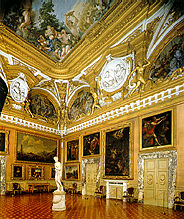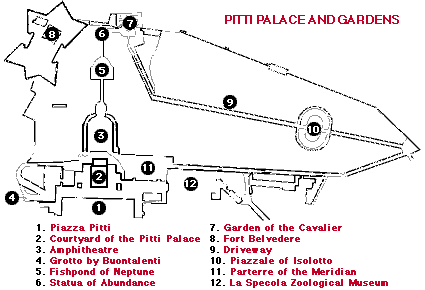Excusez nous mais cette page n'est pas été encore traduite en Français
The group of museums contained in the Pitti Palace were
formed during five centuries of history. It is certainly the largest
museum complex in the city (the building alone is 32.000 square metres in
size) and perhaps can also be considered the most fascinating and complete
of them all, partly for its size and partly for the wide variety of historical,
artistic and naturalistic subjects that the curious visitor can find
exhibited there.
Piazza Pitti marks the start of the visit to the palace.
The square has recently been repaved on the same design as that used in
the 18th century, with three stone-paved driveways up to the door (one straight
up the centre of the square and the other two on either side), with the
remaining space filled in with a chipped stone and cement mixture, that
looks rather like gravel and whose warm colour enhances and blends in with
the royal palace's facade. The square is dominated by the powerful elongated
palace building, which Maria de' Medici, Queen of France (1573-1642), used
as a model when she had the Luxembourg Palace built in Paris.
Filippo
Brunelleschi designed the original
square-shaped building in around 1440 for the merchant Luca Pitti; the Medici
family bought it in 1550, during the reign of Cosimo
I, and work immediately got under way on the enlargements under Bartolomeo
Ammannati (he designed the extraordinary courtyard), followed by Giulio
and Alfonso Parigi (who extended the facade to its present size between
1620 and 1640-50), and, under the Lorraines, architects Giuseppe Ruggeri,
Gaspare Maria Paoletti and Pasquale Poccianti, who added the two lateral
wings curving around the square (called Rondòs) and the Palazzina
of the Meridiana.
Looking up over and past the Palace rooftop, we can
see the trees of the Boboli
Gardens, which, covering 320.00 square metres of land, are full of
grottos, fountains and statues and sprawl along the slopes of the hill
of the same name. Higher up, behind the ramparts built by Michelangelo during
the Seige of Florence (1529), the hill
of Boboli is blocked off by the elegant little palace of Fort
Belvedere, or the Fort of San Giorgio, designed by Bernardo Buontalenti
(1590-1600) for defensive purposes but used more in particular as a
strong-room for the Medici treasury.

Buontalenti,
Fort Belvedere
Between them, the palace and garden contain eight different museum collections. The first and foremost is the Palatine Gallery (25 rooms), the royal family's "private" picture gallery, the result of the Medici and Lorraine family's passion for collecting and certainly no less important than the Uffizi Gallery for the quality of the paintings exhibited there (about a thousand). Then there is the Gallery of Modern Art (30 rooms), containing a collection of 2000 works dating from the 18th-19th century, the nucleus of which is based on the Macchiaioli school (Italian Impressionists); the Silver Museum, exhibiting the priceless vases that once belonged to Lorenzo the Magnificent as well as numerous pieces created by Florentine and German goldsmiths. There is also the Costume Gallery, founded in recent years; the Porcelain Museum, with Meissen, Doccia, Vincennes and SÈvres tableware (in the little Casino del Cavaliere in the Boboli Gardens); the Coach Museum; and the paintings in the Contini-Bonacossi Collection (soon to be transferred to the Uffizi Museum).

Palatine Gallery, Room of Venus
Last, but not least, we can find the Monumental Apartments in the right-hand wing of the piano nobile, which have been arranged with some of their original 17th century furnishings but are, above all, a reminder of Vittorio Emanuele II of Savoy's short sojourn (see the Throne Room) when Florence was the capital of the Kingdom of Italy (1865-71).
The visit to the museums and the apartments (about 140 rooms) also means that it is possible to admire the frescoes inside the various rooms, most of them carried out between 1608 and 1706 by artists like Bernardino Poccetti, Alessandro Allori, Volterrano, Giovanni da San Giovanni, Pietro da Cortona, Ciro Ferri, Salvator Rosa, Anton Domenico Gabbiani and Sebastiano Ricci.
Leaving the Palace, we can continue along Via Romana until we reach the Specola Museum (at number 17), which was previously an astronomic observatory and has contained the natural science collections of the Grand Dukes since 1775. It is famous in particular for its collection of 1.400 anatomical wax figures modelled by Zumbo and Clemente Susini (1775-1814).

